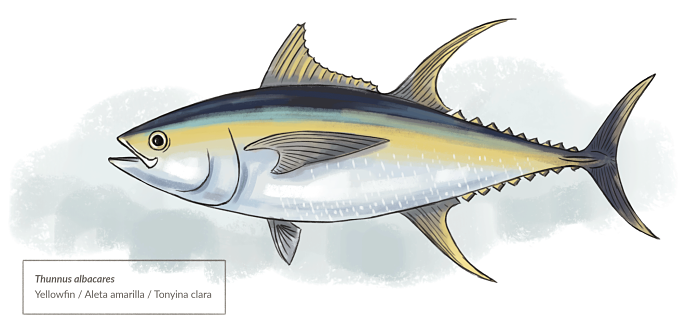What is the life cycle of the yellowfin tuna and its migration routes?
______________________
Claudio, from A Coruña, Spain, sent us the following question: Can you tell me about the life cycle of the yellowfin tuna and its migration routes?
Patricia, from Planet Tuna, answered: It took us longer than we expected to answer this question, because we had to check with the experts and read research papers to realize that there’s still a lot we don’t know about the ecology of this species. For example, some studies show that there’s one single population of yellowfin tuna, which breeds on both sides of the Atlantic Ocean; others suggest the presence of two separate, large yellowfin populations in the Atlantic –one Eastern and one Western. Right now, yellowfins are managed as a single population, which means that much more research has to be done.

Let’s start with what we do know. The yellowfin tuna’s life cycle is one of the best-known among the different tuna species, because the Inter-American Tropical Tuna Commission has a laboratory in Achotines (Panama) where experts have been researching its development for years. The life cycle of all tunas is very similar during the egg and larval stages, so you can read our article about the life cycle of the Atlantic bluefin tuna: up until the juvenile stage, both species develop very much the same way. In fact, their eggs are hard to tell apart at first glance, and the only visible difference between the larvae is their pigmentation. The two species differ a lot more in their adult stage. Yellowfins are smaller as adults than Altantic bluefins (although they can be up to two meters long). They start breeding earlier, when they are 2 years old, whereas Atlantic bluefins reach their age of reproduction at 4-6 years. They breed for several months in a row, in tropical waters –in the Gulf of Mexico, the southern Caribbean, off the coast of Senegal, and in the Gulf of Guinea.

As far as the yellowfin’s migration routes are concerned, our colleague Miguel Cabanellas, a scientist at the Spanish Institute of Oceanography, tells us that we know much less about this topic than we do about its life cycle. Little is known about the yellowfin’s migratory patterns. What seems to be sure is that these tunas travel in search of the best areas for feeding –for example, places that are rich in nutrients– or for breeding, which requires, among other things, waters with the right temperature for the eggs and the larvae to survive. The main spawning grounds of the Western population are the Gulf of Mexico (May through July) along with the southern Caribbean (October through March). The same occurs with the areas where the Eastern population spawns: Senegal (April through June) and the Gulf of Guinea (October through March). This last area (the Gulf of Guinea) is not only one of the main spawning grounds, but also a key area for recruitment, which is the moment when, after having reached a certain size or for other reasons, the fish start to be fished for the first time. Juveniles that hatched in this area migrate from north to south along the African coast in search of warmer waters and better food supplies, to then disperse across the entire tropical Atlantic when they reach adulthood. In fact, some studies suggest that the adults migrate across the ocean and that there may be a central area of the Atlantic (30ºW) where adults from both populations gather to reproduce.
Kitchens, L. L. (2017). Origin and Population Connectivity of Yellowfin Tuna (Thunnus albacares) in the Atlantic Ocean (Doctoral dissertation, Texas A&M University).
Margulies, D., Scholey, V. P., Wexler, J. B., & Stein, M. S. (2016). Research on the reproductive biology and early life history of yellowfin tuna Thunnus albacares in Panama. In Advances in tuna aquaculture (pp. 77-114). Academic Press.



